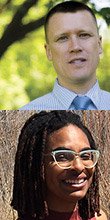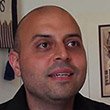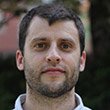Eight Faculty Projects Receive Digital Humanities Curricular Grants
In an effort to bolster the use of digital tools and platforms in the humanities, nine faculty members working on eight projects will be supported by Digital Humanities Curricular Development Grants from the Provost's Office. The recipients of these grants, awarded for the first time earlier this fall, represent philosophy, linguistics, peace and conflict studies, sociology and anthropology, English literature, modern languages, and film and media studies.
Associate Professor of English Literature Rachel Sagner Buurma '99, chair of the selection committee, is excited by the diversity of courses and approaches represented.
"Faculty are teaching students to create GIFs as a form of film analysis," she says, "using mind-mapping software to study connections between types of philosophical arguments, analyzing the social media profiles of activists, distant reading Spanish literature, learning to do linguistic corpus analysis, building language databases, writing Wikipedia entries, and more." Buurma adds that library staff members are helping faculty deposit copies of the teaching materials they develop into Works, Swarthmore's institutional repository.
The inaugural grant recipients include:
Mind Maps
 Course: Philosophy of Mind
Course: Philosophy of Mind
Instructor: Professor of Philosophy Alan Baker
This project combines two digital humanities tools to explore the interconnections between different philosophical theses about the nature of the mind. The project will run in conjunction with the intermediate-level course Philosophy of Mind (Phil 86) in Spring 2018. The first component of the project involves using software to map out key arguments in the philosophy of mind. The second component involves an online survey of over 3000 philosophers. Students will use the argument maps to pick out pairs of theses that seem to be dialectically connected. Students will then use data from the survey to investigate how philosophers’ acceptance of one thesis is in fact connected to their acceptance of the other. The hope is that these digital humanities tools will provide a powerful – and novel – way to explore a core area of philosophical inquiry concerning our fundamental nature as thinking beings.
Contributing to Wikipedia
 Course: Black Culture in a Post-Soul Era
Course: Black Culture in a Post-Soul Era
Instructor: Associate Professor of English Literature Anthony Foy
The grant will support work to incorporate a major digital project into an existing course, Black Culture in a Post-Soul Era (ENGL 68), next offered in Spring 2018. As an interdisciplinary course, ENGL 68 prompts students to analyze the distinctive qualities, characteristics, and concerns of African American literature in the wake of the Civil Rights movement; they come to understand the contemporary moment in black culture as they struggle to situate, define, and describe it. Because a scholarly consensus about African American literature and culture of the last 30 years hasn’t emerged, this course allows students to contribute to a larger understanding of this period. In order to make students’ work in ENGL 68 more collaborative and more public, the course will be restructured around a central project that requires students to identify, create, edit, and/or expand relevant articles on Wikipedia, thereby producing accessible knowledge that serves publics well beyond the classroom.
Exploring social change through word usage: An exercise in corpus linguistics
 Course: Anthropological Linguistics/Linguistic Anthropology
Course: Anthropological Linguistics/Linguistic Anthropology
Instructors: Professor of Linguistics David Harrison and Assistant Professor of Linguistics Jamie Thomas
Students will learn basic methods in corpus linguistics, an emerging field at the intersection of humanities and quantitative social science. They will learn how to search large English language corpora (e.g., the 900 million word Cambridge International Corpus) to look for otherwise hidden patterns of language use. They will be able to track the emergence of new words, shifts in meaning in existing words, and note the obsolescence of some words. They will interpret their findings in light of how language usage reflects societal attitudes and social change.
Ever-expanding publics: Tracing Israeli and Palestinian human rights activism through social media
 Course: Israeli-Palestinian Conflict
Course: Israeli-Palestinian Conflict
Instructor: Visiting Assistant Professor of Peace and Conflict Studies Sa’ed Atshan
Students in Atshan's Israeli-Palestinian Conflict Fall 2016 course, in conjunction with preparing for their 10-day winter study trip to Israel/Palestine, will examine scholarship on digital media and political violence. They will connect those frameworks to Israeli and Palestinian human rights activism by following key activists on social media and analyzing their self-representation to growing audiences in Israel/Palestine and around the world.
DH redesign of an existing introductory literature survey
 Course: Introduction to Spanish Literature/Introducción a la literatura española (SPAN 22)
Course: Introduction to Spanish Literature/Introducción a la literatura española (SPAN 22)
Instructor: Visiting Assistant Professor of Spanish Eli Cohen
This project represents an initial attempt to redesign Spanish 022, an introductory survey of Spanish literature from the Middle Ages through the present, in a manner that integrates digital tools with literary and historical scholarship at the undergraduate level. In addition to more traditional methods of critical analysis, students will be asked to engage with and develop complementary modes of thinking about and presenting the history of Spanish literature through practices associated with ‘distant reading’ and the development of a digital exhibition consisting of a visual and textual chronology of Spanish literature from its origins through the 21st century. The central objective of this redesign is to enable students to engage with a broad array of material in a non-traditional format in order to better understand the relationships that emerge between different objects of study; to assemble these objects of study according to both linear and non-linear models; and to visualize and present verbal data in unconventional and unexpected ways.
Working with the Wamesa Talking Dictionary
 Course: Structure of Wamesa
Course: Structure of Wamesa
Instructor: Visiting Assistant Professor of Linguistics Emily Gasser
Structure of Wamesa (LING 67) takes students through the grammatical structures (sound patterns, syntax, affixes and word building) of Wamesa, an endangered Austronesian language from West Papua, Indonesia, situating them in linguistic theory and typology. Students also explore the cultural context in which Wamesa is spoken, folktales and mythology in a regional context, and issues surrounding gathering language data from speakers. This project will further develop the Wamesa Talking Dictionary, a primary resource for the class. Students use it as a source of raw data, as when they listen to sound clips to determine the sound inventory of the language and investigate its phonetic properties; as a lexical resource to build sentences demonstrating their understanding of Wamesa's grammatical patterns; and as an example of the form for a critical discussion of lexicographical practice, in which they compare online versus print dictionaries to look at what functions and audiences they serve and how different media and design choices can support or undermine those uses.
Queering Media
 Course: Queer Media
Course: Queer Media
Instructor: Eugene Lang Research Professor of Film and Media Studies Patricia White
Teams of two students in White's Queer Media class will produce five-minute audiovisual essays in which they use text, graphics, and/or voiceover to analyze LGBT representations from classical Hollywood, European art, or avant-garde films. They will draw on theoretical readings assigned for class and use the screencasting and video editing software Camtasia, taking some time to reflect on how Camtasia’s affordances and limits structure the audiovisual essays they create.
GIF Analysis
 Course: Introduction to Film and Media Studies (FMST 01)
Course: Introduction to Film and Media Studies (FMST 01)
Instructor: Professor of German Sunka Simon
In this assignment, students in Introduction to Film and Media Studies will learn shot-by-shot analysis of a film scene through learning to create GIF (Graphics Interchange Format) images in place of traditional shot-by-shot analysis formats. Why use GIFs? Because they not only force students to de-construct a film scene into its segmented layers of time and place, into individual shots and even frames (using Photoshop software, in this case), but also make the semiotic codes (e.g. use of lighting, camera distance) apparent through the repetition of movement in the completed GIF. The complete GIF can be embedded in an essay on a course Wordpress site and thus allow the reader to compare interpretations and analysis with the moving image, not just the still of a screen capture. This assignment will be supported by a workshop in which students will learn step-by-step how to make GIFs before being asked to create their own.


